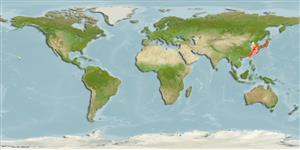Environment: milieu / climate zone / depth range / distribution range
Ekologi
laut dasar (demersal); oceanodromus (Ref. 51243); kisaran kedalaman ? - 100 m. Subtropical; 46°N - 20°N, 116°E - 153°W
Northwest Pacific: Japan and the eastern Korean Peninsula to the Hawaiian Islands.
Size / Weight / umur
Maturity: Lm ? range ? - ? cm
Max length : 150 cm TL jantan/; (Ref. 9988); Berat maksimum terpublikasi: 40.0 kg (Ref. 9988)
deskripsi pendek
Kunci identifiaksi (pengenalan) | Morfologi | Morfometrik
Duri punggung (Keseluruhan (total)) : 6 - 7; duri punggung lunak (Keseluruhan (total)) : 29 - 36; Duri dubur: 3; Sirip dubur lunak: 17 - 22; vertebrata, bertulang belakang: 24. Scutes absent. Compared to S. lalandi, the species' dorsoposterior corner of upper jaw is angular (versus rounded) and the pectoral and pelvic fins are almost equal in length (versus pectoral shorter than pelvic fin).
Adults exhibit shoaling habit (Ref. 9988). They feed on plankton. Juveniles are found among floating seaweeds (Ref. 12114, 12115). Collection of young is the basis for prosperous aquaculture in Japan. Raised in captivity and marketed fresh for sashimi (Ref. 9988).
Life cycle and mating behavior
Kematangan | Reproduksi, perkembang biakan | Pemijahan | telur-telur | Fecundity | Larva
Robins, C.R., R.M. Bailey, C.E. Bond, J.R. Brooker, E.A. Lachner, R.N. Lea and W.B. Scott, 1991. World fishes important to North Americans. Exclusive of species from the continental waters of the United States and Canada. Am. Fish. Soc. Spec. Publ. (21):243 p. (Ref. 4537)
Status IUCN Red List (Ref. 130435: Version 2024-2)
ancaman kepada manusia
Harmless
penggunaan manusia
Perikanan: bernilai komersial tinggi; Budidaya air: komersial; Ikan buruan: ya
Alat, peralatan
laporan khas
muat turun XML
Sumber internet
Estimates based on models
Phylogenetic diversity index (Ref.
82804): PD
50 = 0.5020 [Uniqueness, from 0.5 = low to 2.0 = high].
Bayesian length-weight: a=0.01122 (0.00514 - 0.02450), b=3.04 (2.87 - 3.21), in cm total length, based on all LWR estimates for this body shape (Ref.
93245).
Trophic level (Ref.
69278): 4.0 ±0.65 se; based on food items.
Generation time: 3.4 ( na - na) years. Estimated as median ln(3)/K based on 1
growth studies.
Daya lenting (Ref.
120179): sedang, Waktu penggandaan populasi minimum 1.4 - 4.4 tahun (K=0.3-0.5).
Prior r = 0.57, 95% CL = 0.38 - 0.85, Based on 1 data-limited stock assessment.
Fishing Vulnerability (Ref.
59153): Moderate to high vulnerability (52 of 100).
Climate Vulnerability (Ref.
125649): Very high vulnerability (100 of 100).
Nutrients (Ref.
124155): Calcium = 52.4 [32.1, 127.7] mg/100g; Iron = 1.36 [0.76, 2.65] mg/100g; Protein = 18.9 [16.0, 21.8] %; Omega3 = 0.334 [0.213, 0.557] g/100g; Selenium = 37.3 [19.1, 79.6] μg/100g; VitaminA = 17.4 [2.2, 126.7] μg/100g; Zinc = 0.428 [0.301, 0.639] mg/100g (wet weight);
